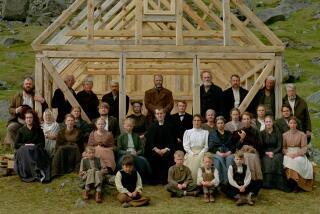MOVIE REVIEW : Loony Folk History in ‘Gimli’
“Tales From the Gimli Hospital” (a new Friday-midnight movie at the Nuart) is such an oddball little show--a Canadian regional production shot for $22,000 and based, tongue-in-cheek, on the folk history of a small Icelandic fishing community in Manitoba--that some audiences may get weirded out during the credits.
It’s a dry, fluky comedy about the perils of immigrant communities and bad health facilities--shot in a style that’s a clever pastiche of early ‘30s experimental talkies. The imagery is purposely deranged and the movie pumps it out in slow, deliberate rhythms that become daffy and excruciating.
Sultry vamp nurses, made up like Valley Girl versions of Louise Brooks, try to heal victims of a mysterious epidemic by rubbing their sores with dead sea gulls. Three angelic little girls vanish hand-in-hand in a sylvan wood and later float back down a river in individual coffins.
The characters have names like Einar the Lonely, Elfa Egilsdottir, Lord Dufferin and the Fish Princess. Einar, the crazed hero, (Kyle McCulloch) pomades his hair with fish grease squeezed right from the fish, violates a corpse on an Indian burial platform and indulges in a bout of nocturnal, buttock-grabbing wrestling while bagpipes wail.
Meanwhile, the whole dolorous history is recounted by an ample nurse, Amma (Margaret-Anne McCleod) to two children on a death watch in their mothers’ contemporary Gimli hospital room; here, “contemporary” means the early ‘30s.
There’s a loony concentration to “Gimli” (Times-rated: Mature, for style, theme and sexuality). Much of it revolves around the two epidemic victims, Einar and Gunnar (Michael Gottli), as they lie in the filthy, turn-of-the century Gimli Hospital--a makeshift facility in a hay-strewn barn--staring at each other with increasing hostility from their separate beds.
Winnipeg writer-director-editor-photographer, Guy Maddin--whose grandmother was an Icelandic immigrant--has quite an imagination and a talent for pastiche. Maddin tries to capture the look and feel of the early low-budget experimental talkies or late silents, and he’s amazingly good at it.
More to Read
Only good movies
Get the Indie Focus newsletter, Mark Olsen's weekly guide to the world of cinema.
You may occasionally receive promotional content from the Los Angeles Times.










